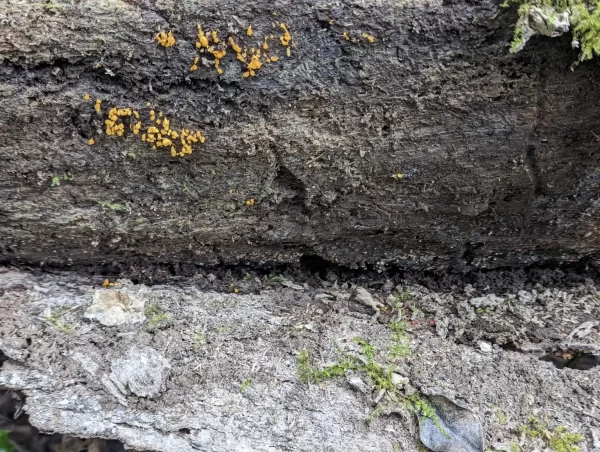Slime Moulds & Eyelash Fungi on Decaying Trunk at Strumpshaw Fen – March & April 2024
Throughout February and March—in the reserve woodland—we came across a number of groups of Hemitrichia slime moulds and Scutellinia (eyelash fungus).
March
Notably, this decaying trunk at The Dell—that the daughter found—hosted Hemitrichia and Scutellinia. Also present were Daldinia concentrica (King Alfred’s cakes) suggesting an ash tree (Fraxinus excelsior).

The Dell at Strumpshaw Fen
24th March 2024

The Dell at Strumpshaw Fen
24th March 2024
Hemitrichia clavata
Hidden Forest
STALK: Stalk cylindrical, 0.1 to 1.5 mm, long, furrowed or nearly even, olive, reddish brown, or nearly black, filled with spore-like cells.
NOTES: Very similar to H. calyculata but with a larger spore size and shape of peridium.
Danish Myxomycetes
The stalk gradually widened upwards, not clearly distinguishable from the peridial cup.
Hemitrichia calyculata
Hidden Forest
STALK: slender, reddish brown to black, 0.5-2.0 mm long, expanded at the top to form a distinct funnel-shaped cup.
PERIDIUM: membranous, yellow, persisting in the lower half as a distinct calyculus that often has a petaloid margin.
Danish Myxomycetes
Peridial cup rather abruptly separated from the stalk.
In the photo below there’s Hemitrichia on the sapwood and Scutellinia on the peeling bark (left of centre of the first trunk photo above).

The Dell at Strumpshaw Fen
24th March 2024
Close up of the Scutellinia on the bark

The Dell at Strumpshaw Fen
24th March 2024
More Scutellinia (just right of centre in the second trunk photo above).

The Dell at Strumpshaw Fen
24th March 2024
The daughter noticed that one group of Scutellinia was surrounded by the remains of a King Alfred’s cake (far right in second trunk photo above).

The Dell at Strumpshaw Fen
24th March 2024
Close up of the group above.

The Dell at Strumpshaw Fen
24th March 2024
Groups of Scutellinia below the King Alfred’s cake remnant.

The Dell at Strumpshaw Fen
31st March 2024

The Dell at Strumpshaw Fen
31st March 2024
Sporing Hemitrichia…

The Dell at Strumpshaw Fen
24th March 2024

The Dell at Strumpshaw Fen
24th March 2024

The Dell at Strumpshaw Fen
24th March 2024
These Hemitrichia were somewhat different in structure and colour to the Hemitrichia we found at the end of the trail.
The stalk and cups of these sporangia on the trunk seem to merge more gradually—the stalk and cup are less distinct—and overall more yellow.
Hemitrichi clavata and Hemitrichi calyculata are very similar but the literature states that H. clavata is distinguished from H. calyculata by a deeper cup that tapers to merge with the stem. H. calyculata has a narrower stem and a shallower cup that is more abruptly separated from the stem [1][2][3].
Mid April
In mid April the Scutellinia was still prolific but the Hemitrichia was diminishing.
The daughter spotted some clay-buff Stemonitis spore mass sporangia (below right just off-centre in the photo below).

The Dell at Strumpshaw Fen
14th April 2024
Close up of the Stemonitis.

The Dell at Strumpshaw Fen
14th April 2024
And a solitary, developing Lycogala aethalium.

The Dell at Strumpshaw Fen
14th April 2024
Close up we noticed the rose peridium was broken exposing the scarlet goo inside.

The Dell at Strumpshaw Fen
14th April 2024
[1] Myxomycetes : A Handbook of Slime Molds – Stephenson & Stempen.